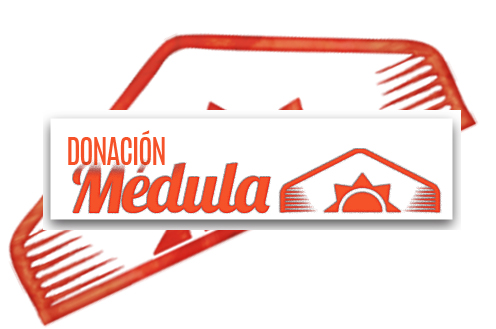Saturday is World Bone Marrow Donor Day
This year Spain will pass the 250,000 donor mark thanks to the new National Bone Marrow Plan
News - 2016.9.16
In this way, the World Marrow Donor Association has lent its support to the international campaign which southern European countries, including Spain, have been organising for some years now on around this same date. The WMDA brings together registries of bone marrow and umbilical cord blood donors from all over the world, including those in our country.
Over 28 million people worldwide are now marrow donors, to which we can add a further 650,000 plus cords of umbilical cord blood (UCB) stored around the world. Spain now has over 230,000 bone marrow donors and approximately 60,000 cords stored in public cord banks, which accounts for nearly 10% of all the world reserves of UCB. Our country ranks second in the world, after the USA, in terms of stored UCB.
Our country has also made a major effort in recent years to modernise the bone marrow donation system and attract more donors. In January 2013, the National Transplant Organisation (Spanish acronym: ONT) and the autonomous regions, in collaboration with scientific societies and associations of patients, set up the National Bone Marrow Plan with the aim of reaching the figure of 200,000 donors by the end of 2016. This target was achieved a year ahead of time.
This plan has had the economic backing of the Ministry of Health, Social Services and Equality. Over the last four years, the ministry has provided 2.32 million euros (830,000 euros a year since 2013), to finance typing jointly with autonomous regions.
Towards the end of last year the ONT and the autonomous regions agreed to renew the National Bone Marrow Plan with a new challenge; to reach the figure of 400,000 donors by 2020, an annual increase of 40,000 donors.
This new plan has already begun to bear fruit. In fact, the National Transplant Organisation and the Spanish Register of Bone Marrow Donors (Spanish acronym: REDMO) expect Spain to pass the 250,000-donor mark by the end of the year. So far this year, bone marrow donation has been growing at a rate of 120 new donors a day.
Since the National Bone Marrow Plan was set in motion (2013), the number of donors will have increased by 133% by the end of this year if the ONT's forecast is accurate.
In 1990, when REDMO was set up, our country had just 102 donors.
ONT-REDMO, the International Josep Carreras Foundation, scientific societies and associations of patients, and all the other participants in the National Bone Marrow Plan, congratulate the citizens of Spain on this achievement and encourage them to find out about the importance of this type of donation, and to continue to donate bone marrow and umbilical cord blood, two of the main sources of blood stem cells that may be needed for transplant purposes.
International solidarity
They also recall that the donation of bone marrow and umbilical cord blood are governed by the principle of international solidarity. When a donor's data is recorded in the Spanish Bone Marrow Registry, this data is automatically sent to the world registry where it is available to any patient in the world who may need to make use of it.
When a patient needs a transplant of this type, the haematologist gets in touch with REDMO (Spanish Bone Marrow Donors Registry) which starts the search in Spain both among marrow donors and among stored cord blood units, and if no suitable donor is found in the national registries, the search is extended to the Bone Marrow Donors Worldwide (BMDW) registry.
It is precisely the international and networked nature of the search that ensures that all patients have the same possibility of finding a marrow donor or an umbilical cord unit, regardless of the country they come from.
According to data from the ONT, a donor or umbilical cord blood unit is currently found in REDMO or in international registries for around 90% of all patients in an average of 33 days, although the ultimate aim is to achieve full self-sufficiency.
Regarding bone marrow donation and transplant
The ONT recalls the basic requirements for marrow donors:
- To be between 18 and 55 years old (although those already registered may be donors until they are 60).
- To be in good health; that is to say, not suffering from any illness that could be passed on to the receptor. Neither may potential donors suffer from any illness that may put their own life in danger if they donate.
- It is also important to bear in mind that you cannot donate to a specific patient; you donate to any compatible person requiring a donor, wherever he or she may live.
- To be a marrow donor means taking on a lifelong commitment. It means becoming part of a select world club of healthy, caring people, who know that at any time they may be called upon to save the life of an anonymous patient anywhere in the world.
Acute leukaemia, lymphoma and multiple myeloma are the main pathologies that may require a bone marrow transplant. In our country, nearly 5,000 people every year are diagnosed with acute leukaemia, around 7,000 with lymphoma, nearly 2,000 with multiple myeloma. Meanwhile leukaemia is the most common childhood cancer; it accounts for 30% of all childhood oncological blood diseases. 70% of patients who can benefit from this type of transplant need a non-related donor.
The ONT has made a video with information on bone marrow donation and transplantation; it is available at the following link:
https://www.youtube.com/watch?v=MVFYh1zsPHM
Further information is available on the ONT's website (www.ont.es), where you will find a microsite dedicated to bone marrow donation.





